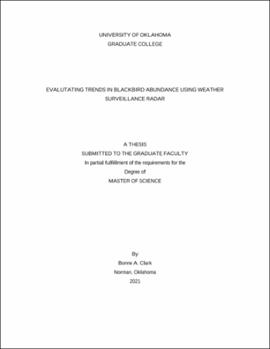| dc.description.abstract | Blackbirds damage rice in the southern United States, sunflowers in the Northern Great Plains, and field and sweet corn across the continent. The efficacy of strategies to mitigate damages could be improved by knowing how and when blackbird numbers accumulate throughout the season. Methods aimed at reducing avian damage to agricultural crops are routinely implemented in situations where efficacy can be assessed by quantifying blackbird (Icteridae) abundance relative to environmental variables and extrapolating to ensuring crop damage. Weather surveillance radar (WSR) has been successfully used as a tool to estimate abundances of airborne species such as birds, bats, and insects. Using WSR to estimate numbers of blackbirds at a roost can be inherently useful to inform managers at what point in the season blackbird numbers peak, a period when higher crop damages are expected, and when they depart for migration. Knowing this, producers may be encouraged to plant earlier and harvest their crops before substantial damage occurs. My thesis explores using weather surveillance radar data of a large blackbird roost in North Dakota to evaluate 1) annual crop yield losses to local sunflower, and 2) atmospheric drivers of annual fall blackbird migration.
In chapter one, I evaluated annual damages to local sunflowers from blackbirds at a fall roost in North Dakota, from 2012 to 2019. I used weather surveillance radar (WSR) to derive daily abundance estimates of blackbirds at the roost. I integrated these estimates with previously developed bioenergetics economic models to estimate damages to local sunflower crops. The greatest damages occurred in mid-October, when peak blackbird abundance coincided with the majority of mature but unharvested sunflower fields. Most sunflower fields were harvested later than the peak of blackbird abundance which resulted in large daily damages, suggesting that advancing harvest time should be considered as a strategy for producers to avoid the greatest losses in yield.
In chapter two, I evaluated the effects of atmospheric drivers on blackbirds’ decision to migrate in the fall over a nine-year period (2012 – 2020) at a fall roost in North Dakota. Using weather surveillance radar and local climatological data, I used an AIC model-comparison approach to determine the best weather candidate model to explain blackbird departure from the roost. The best model of departure included Julian date and the daily changes in pressure, v-component of wind strength, and temperature. The integrated model accounted for nearly all the model weight (0.996) in the candidate set. The results show that on average, the final departure of blackbird was on 16 November, when weather conditions were on average at 982 mb (29 in Hg), -7○C, winds were 9 m/sec, and wind was southbound. The null model of Julian date was not a good fit for factors driving blackbird migration, suggesting that other factors were more important than daylight hours. The pressure variable was in all four of the top models, indicating that changes in pressure impact blackbird’s decision to migrate. Blackbirds generally form fall roosts and then depart on fall migration from those roosts as days get shorter, temperatures drop, and weather fronts pass over the roost. I determined that bouts of fall migration (i.e., from peak abundance to final departure from the roost) is seasonally correlated with the combination of Julian date, rise in pressure following low pressure systems, decreasing temperatures, and southbound winds acting as triggers of fall migratory departure at the focal roost. | en_US |

